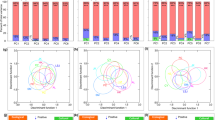Summary
-
1.
As part of an overall study of the social behavior of the little brown bat, Myotis lucifugus, we compiled the vocal repertoire of this gregarious species in its natural habitat. Ten vocalizations were identified and associated with certain behavioral contexts.
-
2.
Echolocation pulses, although primarily used for or entation, are also available as interindividual communication signals and modified forms are used in several situations such as during near-collisions in flight and the first flights of newly volant young.
-
3.
Nonecholocation calls are used in three main contexts. Agonistic vocalizations appear to take the place of physical aggression and may be used to protect an individual's position within a roost. Two vocalizations emitted in maternal-infant situations appear to contain vocal signatures which are important for individual recognition. During mating, a distinct copulation call given by males likely conveys a male's sexual motivation to a female in the absence of precopulatory displays.
-
4.
The size of the vocal repertoire is comparable to those of some solitary mammals. Behavioral observations indicate that despite the gregarious nature of the species, a simple social system exists and the small repertoire is therefore not surprising.
Similar content being viewed by others
References
Barclay, R.M.R., Thomas, D.W.: Copulation call of the bat Myotis lucifugus: A discrete situation-specific communication signal. J. Mammal. 60, 632–634 (1979)
Bradbury, J.W.: Social organization and communication In: Biology of bats, Vol. 3. Wimsatt, W.A. (ed.), pp. 2–72. New York: Academic 1977
Bradbury, J.W., Emmons, L.H.: Social organization of some Trinidad bats. I. Emballonuridae. Z. Tierpsychol. 36, 137–183 (1974)
Bradbury, J.W., Vehrencamp, S.: Social organization and foraging in emballonurid bats. I. Field studies. Behav. Ecol. Sociobiol. 1, 337–382 (1976)
Brown, P.: Vocal communication in the pallid bat, Antrozous pallidus. Z. Tierpsychol. 41, 34–54 (1976)
Dalland, J.I.: Hearing sensitivity in bats. Science 150, 1185–1186 (1965)
Emmons, L.H.: Sound communication among African rainforest squirrels. Z. Tierpsychol. 47, 1–49 (1978)
Ewer, R.F.: The ethology of mammals. London: Elek Science 1968
Fenton, M.B.: Population studies of Myotis lucifugus (Chiroptera: Vespertilionidae) in Ontario. R. Ont. Mus. Life Sci. Contrib. 77, 1–34 (1970)
Fenton, M.B.: Variation in the social calls of little brown bats (Myotis lucifugus). Can. J. Zool. 55, 1151–1157 (1977)
Fourie, P.B.: Acoustic communication in the rock hyrax, Procavia capensis. Z. Tierpsychol. 44, 194–219 (1977)
Gould, E.: Studies of maternal-infant communication and development of vocalizations in the bats Myotis and Eptesicus. Commun. Behav Biol. 5, 263–313 (1971)
Gould, E.: Neonatal vocalizations in bats of eight genera. J. Mammal. 56, 15–29 (1975)
Gould, E.: Echolocation and communication. In: Biology of bats of the New World family Phyllostomatidae. Part II. Spec. Publ. Mus. Tex. Tech. Univ. 13, 247–279 (1977)
Gould, E., Woolf, N.K., Turner, C.: Double-note communication in bats: Occurrence in three families. J. Mammal. 54, 998–1001 (1973)
Griffin, D.R.: Listening in the dark. New Haven: Yale University 1958
Kolb, V.A.: Wie erkennen sich Mutter und Junges des Mausohrs, Myotis myotis, bei der Rückkehr vom Jagdflug wieder?. Z. Tierpsychol. 44, 423–431 (1977)
Kunz, T.H.: Population studies of the cave bat (Myotis velifer): Reproduction, growth and development. Occas. Pap. Mus. Nat. Hist. Kans. 15, 1–43 (1973)
Martin, K., Fenton, M.B.: A possible defensive function for the calls of bats (Myotis lucifugus) arousing from torpor. Can. J. Zool. 56, 1430–1432 (1978)
Möhres, F.P.: Communicative characters of sonar signals in bats. In: Animal sonar systems Biology and bionics, Vol. 2. Busnel, R.G. (ed.), pp. 939–945. Jouy-en Josas: Laboratoire de Physiologie Acoustic 1966
Morton, E.S.: On the occurrence and significance of motivation-structural rules in some bird and mammal sounds. Am. Nat. 111, 855–869 (1977)
Nelson, J.E.: Vocal communication in Australian Pteropodidae (Megachiroptera). Z. Tierpsychol. 21, 856–870 (1964)
Schmidt, U.: Social calls of juvenile vampire bats (Desmodus rotundus) and their mothers. Bonn. Zool. Beitr. 23, 310–316 (1972)
Schott, D.: Quantitative analysis of the vocal repertoire of squirrel monkeys (Saimiri sciureus). Z. Tierpsychol. 38, 225–250 (1975)
Simmons, J.A., Fenton, M.B., Ferguson, W.R., Jutting, M., Palin, J.: Apparatus for research on animal ultrasonic signals. R. Ont. Mus. Life Sci. Misc. Publ. (in press) (1979)
Suthers, R.A.: Acoustic orientation of fish-catching bats. J. Exp. Zool. 158, 319–348 (1965)
Suthers, R.A., Fattu, J.M.: Mechanisms of sound production by echolocating bats. Am. Zool. 13, 1215–1226 (1973)
Thomas, D.W.: Aspects of the social and mating behaviour of the bat Myotis lucifugus (Chiroptera: Vespertilionidae) at hibernacula in Ontario. Unpubl. M.Sc. thesis, Carleton University (1978)
Thomas, D.W., Fenton, M.B., Barclay, R.M.R.: Social behavior of the little brown bat, Myotis lucifugus. I. Mating behavior. Behav. Ecol. Sociobiol. 6, 129–136 (1979)
Trune, D.R., Slobodchikoff, C.N.: Social effects of roosting on the metabolism of the pallid bat (Antrozous pallidus). J. Mammal. 57, 656–663 (1976)
Turner D., Shaughnessy, A., Gould, E.: Individual recognition between mother and infant bats (Myotis). In: Animal orientation and navigation. Galler, S.R., Schmidt-Koenig, K., Jacobs, G.J., Belleville, R.E. (eds.), pp. 365–371. NASA SP-262 1972
Vaughan, T.A.: Nocturnal behavior of the African false vampire bat (Cardioderma cor). J. Mammal. 57, 227–248 (1976)
Wilson, E.O.: Sociobiology: The new synthesis. Cambridge: Belknap Press of the Harvard University Press 1975
Author information
Authors and Affiliations
Rights and permissions
About this article
Cite this article
Barclay, R.M.R., Fenton, M.B. & Thomas, D.W. Social behavior of the little brown bat, Myotis lucifugus . Behav Ecol Sociobiol 6, 137–146 (1979). https://doi.org/10.1007/BF00292560
Received:
Accepted:
Issue Date:
DOI: https://doi.org/10.1007/BF00292560




